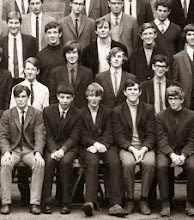
My family is Northern way back, but we didn't spring out of the soil here. Within traceable records, there are comer-in from Kent and Birmingham, and lost in the more distant past, various bits of Northern Germany. Probably. Who cares? The point robustly made in True North is that we have always benefited from welcoming immigrants, and there is a wealth of books and pamphlets to prove that. I ,ade good use of Roisin Ban (White Rose), Corinne Silva's lovely photographic essay on the Irish in Leeds, with thoughtful essays by Brendan McGowan (Leeds Irish Health and Homes 2006).
 With Walt Whitman in Bolton by Paul Salveson (Little Northern Books 2008) opens a wistful American connection (lots of Northerners went to the States, including many Mormons and Mr Wrigley of saddleworth, immortalised (appropriately for a Northerner) by gum. In that context, Aspects of Barnsley vol 3 Wharncliffe Publishing 1995) has a great article by Brian Elliott called When Buffalo Bill Came to Barnsley (which he did, in 1904. Homeworkers UK provided me with a gentle and encouraging account of Indian-origin citizens of Leeds, Stitching Stories from Bihar to Beeston (Homeworkers Worldwide 2005) and Religion in Leeds edited by Alan Mason (Sutton 1994) added very useful material on other Asian groups as well as the city's famous Jewish community. Religion and Place in Leeds by John Minnis and Tevor Mitchell took the story on (English Heritage 2007) and City of Peace edited by Carol Rank (Bradford Libraries 1997) did the same for Bradford.
With Walt Whitman in Bolton by Paul Salveson (Little Northern Books 2008) opens a wistful American connection (lots of Northerners went to the States, including many Mormons and Mr Wrigley of saddleworth, immortalised (appropriately for a Northerner) by gum. In that context, Aspects of Barnsley vol 3 Wharncliffe Publishing 1995) has a great article by Brian Elliott called When Buffalo Bill Came to Barnsley (which he did, in 1904. Homeworkers UK provided me with a gentle and encouraging account of Indian-origin citizens of Leeds, Stitching Stories from Bihar to Beeston (Homeworkers Worldwide 2005) and Religion in Leeds edited by Alan Mason (Sutton 1994) added very useful material on other Asian groups as well as the city's famous Jewish community. Religion and Place in Leeds by John Minnis and Tevor Mitchell took the story on (English Heritage 2007) and City of Peace edited by Carol Rank (Bradford Libraries 1997) did the same for Bradford.  Stass Paraskos by Norbert Lynton (Orage Press 2003) is a lively account of a very lively Cypriot painter and his time at Leeds College of Art which he much enriched. An Artist's Odyssey by Robert Waterhouse (Jean-Georges Simon Foundation 2005) tells the equally interesting story of the Hungarian artist Jean-George Simon who moved in exile to Ramsgill in Nidderdale.A Pedlar's Legacy by Patrick Beaver (Henry Melland 1981) tells the story of the Fattorini family from Italy and their creation, Empire Stores. Aspects of Leeds vol 1 (Wharncliffe Publishing 1998) has another good article on the Jewish community's history by Murray Freedman, a great expert on the topic. In Excited Times by Nigel Todd (Bewick Press 1995) tells the story of 'the people against the Blackshirts' during Sir Oswald Mosley's forays North in the turbulent 1930s. To Live it is to Know it by Alfred Williams and Ray Brown (Yorkshire Arts Circus 1987) leaves you in no doubt about the challenges facing new arrivals (and long-standing ones, too often) from the Caribbean.
Stass Paraskos by Norbert Lynton (Orage Press 2003) is a lively account of a very lively Cypriot painter and his time at Leeds College of Art which he much enriched. An Artist's Odyssey by Robert Waterhouse (Jean-Georges Simon Foundation 2005) tells the equally interesting story of the Hungarian artist Jean-George Simon who moved in exile to Ramsgill in Nidderdale.A Pedlar's Legacy by Patrick Beaver (Henry Melland 1981) tells the story of the Fattorini family from Italy and their creation, Empire Stores. Aspects of Leeds vol 1 (Wharncliffe Publishing 1998) has another good article on the Jewish community's history by Murray Freedman, a great expert on the topic. In Excited Times by Nigel Todd (Bewick Press 1995) tells the story of 'the people against the Blackshirts' during Sir Oswald Mosley's forays North in the turbulent 1930s. To Live it is to Know it by Alfred Williams and Ray Brown (Yorkshire Arts Circus 1987) leaves you in no doubt about the challenges facing new arrivals (and long-standing ones, too often) from the Caribbean. Far Headingley by David Hall (Far Headingley Village Society 2000) has an excellent microcosm of unusual newcomers to a well-off and intellectual Leeds suburb, including Prince Alamayou of Abyssinia who stayed with Arthur Ransome's family (see picture). J.B.Priestley's Yorkshire edited by W R Mitchell (Dalesman 1987) has some excellent passages by the sturdy old warrior on the benefit of German and Jewish immigrants to Bradford (among them the family of Michael Wharton, the Daily Telegraph's erstwhile Peter Simpson, who betrayed his origins with some nasty (however witty) comments about Asian immigration to the city. Finally Ebor: the Archbishops of York by A Tindal Hart (William Sessions 1986) unexpectedly showed the international richness of past occupants of that job. And now, Hooray!, we have John Sentamu.
Far Headingley by David Hall (Far Headingley Village Society 2000) has an excellent microcosm of unusual newcomers to a well-off and intellectual Leeds suburb, including Prince Alamayou of Abyssinia who stayed with Arthur Ransome's family (see picture). J.B.Priestley's Yorkshire edited by W R Mitchell (Dalesman 1987) has some excellent passages by the sturdy old warrior on the benefit of German and Jewish immigrants to Bradford (among them the family of Michael Wharton, the Daily Telegraph's erstwhile Peter Simpson, who betrayed his origins with some nasty (however witty) comments about Asian immigration to the city. Finally Ebor: the Archbishops of York by A Tindal Hart (William Sessions 1986) unexpectedly showed the international richness of past occupants of that job. And now, Hooray!, we have John Sentamu.













